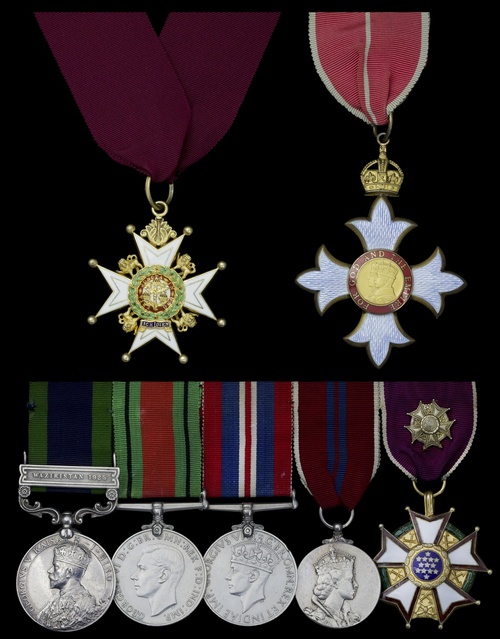
Auction: 19001 - Orders, Decorations and Medals
Lot: 587
An unusual post-war C.B., C.B.E. group of seven awarded to Air Vice-Marshal F. G. S. Mitchell, Royal Air Force
Having won entitlement to the rare 'Waziristan 1925' clasp for his services as a Flying Officer in No. 27 Squadron's D.H. 9As, Mitchell attained senior rank as a trail-blazing Armaments Officer
Among other notable achievements, he was sent to Japan in 1946 to inspect and report upon the effects of the Atomic bombs dropped on Hiroshima and Nagasaki and duly co-authored his mission's official report for the Home Office and Air Ministry. Later still, he proved instrumental in developing the Britain's nuclear deterrent
The Most Honourable Order of the Bath (C.B.), Military Division, Companion's neck badge, silver-gilt and enamel, in its Collingwood case of issue; The Most Excellent Order of the British Empire (C.B.E.), Military Division, Commander's 2nd type neck badge, silver-gilt and enamel, in its Garrard & Co. case of issue; India General Service 1908-35, 1 clasp, Waziristan 1925 (F./O. F. G. S. Mitchell, R.A.F.), double stamped letters to 'R.A.F.'; Defence and War Medals 1939-45; Coronation 1953; United States of America, Legion of Merit, Officer's breast badge, gilt and enamel, the reverse machine engraved, 'F. G. S. Mitchell', mounted as worn where applicable, good very fine (7)
C.B. London Gazette 31 May 1956.
C.B.E. London Gazette 1 January 1953.
American Legion of Merit London Gazette 3 May 1946.
Frederick George Stewart Mitchell was born on 14 December 1901 and attended R.A.F. Cranwell as a Flight Cadet in 1920. Duly qualified, he was commissioned Pilot Officer and posted to No. 39 Squadron, a home-based light bomber unit.
Advanced to Flying Officer in June 1924, he next joined No. 27 Squadron and witnessed active service on the North-West Frontier and in Waziristan in the unit's D.H. 9As in the following year. He was one of just 254 men to qualify for the 'Waziristan 1925' clasp, the whole having served under Wing Commander R. C. M. Pink on the first occasion the R.A.F. was deployed independently from the Army.
An appointment at the Armament and Air Gunnery School followed and he was advanced to Flight Lieutenant in June 1928. But he returned to flying duties as a Flight Commander in No. 4 Squadron in late 1933, operating in Hawker Audax light bombers. In April 1936 he was promoted to Squadron Leader, prior to being appointed an Armament Officer at H.Q. R.A.F. Middle East.
By the outbreak of hostilities in September 1939, Mitchell was serving as a Wing Commander in the Technical Branch and it was in this capacity - later as an acting Group Captain - that he remained actively employed for the duration of the war. He was appointed O.B.E. (London Gazette 1 January 1941, refers), in addition to being awarded the American Legion of Merit in May 1946, the latter distinction in consequence of his work as a Member of the British Military Mission of Scientists sent to Japan in 1946. The Mission's brief was to study the effects of the atomic bombs dropped on Hiroshima and Nagasaki, Mitchell co-authoring the official H.M.S.O. report for the Home Office and Air Ministry.
Granted the substantive rank of Group Captain in July 1947, and advanced to Air Commodore in January 1949, he was appointed Director of Armament Engineering in the following year. He subsequently played a key role in establishing the British Nuclear Deterrent and was awarded the C.B.E.
Having then served as A.O.C. No. 43 Group in 1952-55, Mitchell took up his final appointment, namely that of Air Officer Armaments to H.Q. Maintenance Command. Placed on the Retired List as an Air Vice-Marshal in the summer of 1958, he died at Midhurst, Sussex on 13 February 1974; sold with a file of copied research.
Subject to 20% VAT on Buyer’s Premium. For more information please view Terms and Conditions for Buyers.
Sold for
£2,400




